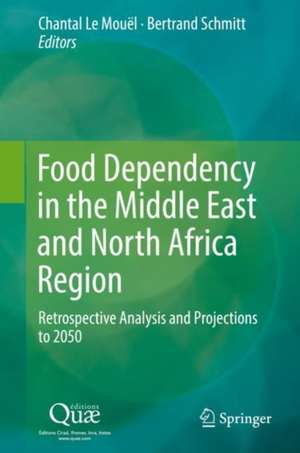Food Dependency in the Middle East and North Africa Region: Retrospective Analysis and Projections to 2050
Editat de Chantal Le Mouël, Bertrand Schmitten Limba Engleză Hardback – 27 sep 2018
| Toate formatele și edițiile | Preț | Express |
|---|---|---|
| Paperback (1) | 553.29 lei 39-44 zile | |
| SPRINGER NETHERLANDS – 10 ian 2019 | 553.29 lei 39-44 zile | |
| Hardback (1) | 557.20 lei 39-44 zile | |
| SPRINGER NETHERLANDS – 27 sep 2018 | 557.20 lei 39-44 zile |
Preț: 557.20 lei
Preț vechi: 696.51 lei
-20% Nou
Puncte Express: 836
Preț estimativ în valută:
106.63€ • 111.19$ • 88.62£
106.63€ • 111.19$ • 88.62£
Carte tipărită la comandă
Livrare economică 17-22 martie
Preluare comenzi: 021 569.72.76
Specificații
ISBN-13: 9789402415629
ISBN-10: 9402415629
Pagini: 116
Ilustrații: XIII, 123 p. 33 illus., 29 illus. in color.
Dimensiuni: 155 x 235 mm
Greutate: 0.36 kg
Ediția:1st ed. 2018
Editura: SPRINGER NETHERLANDS
Colecția Springer
Locul publicării:Dordrecht, Netherlands
ISBN-10: 9402415629
Pagini: 116
Ilustrații: XIII, 123 p. 33 illus., 29 illus. in color.
Dimensiuni: 155 x 235 mm
Greutate: 0.36 kg
Ediția:1st ed. 2018
Editura: SPRINGER NETHERLANDS
Colecția Springer
Locul publicării:Dordrecht, Netherlands
Cuprins
Foreword.- Introduction: A fragile region notable for its growing dependence on agricultural imports.- Chapter 1: Determinants of the growing food dependence (1961-2011).- 1. Food and agricultural demand: growing and changing in nature.- 2. Growth in agricultural production: limited by constraints affecting production factors.- 3. Growing need of agricultural imports.- 4. Imbalance between supply and demand: uncertainties for the future.- Chapter 2: By 2050, a possible strengthening of the regional dependence on agricultural imports.- 1. In 2050, the need for land would still exceed availability.- 2. Growing recourse to agricultural imports.- 3. Agricultural labour productivity could deteriorate.- 4. By 2050, strengthening of import dependence, notably in case of accentuated effects of climate change.- Chapter 3: Brakes and levers to reduce the dependence on imports in the Middle East-North Africa region.- 1. Alternative hypotheses on food consumption oftenlead to increased imports.- 2. Hypotheses for more favourable development of domestic supply.- 3. The effects of halving losses and waste in agricultural products.- 4. Which levers for reducing import dependence of the Middle East-North Africa region?.- Conclusion.- Bibliography.- Annex 1: The GlobAgri-Pluriagri model and database.- Annex 2: The composition of the 36 products and 17 geographical zones in GlobAgri-Pluriagri.
Notă biografică
The editors of this work are Chantal Le Mouël and Bertrand Schmitt
Textul de pe ultima copertă
At present, 40% of the agri-food needs of the Middle-East and North Africa (MENA) region is covered by imports, whereas this figure was just about 10% in the beginning of the 1960’s. Demographic growth and diet change has combined to increase food demand while the region’s agricultural production grew rapidly but much less than demand. In this geopolitically complex region, agricultural imports and food policies represent an important share in state budgets and their actual level could curb development and the fight against poverty. In the future, even higher demographic growth and increased climate change could sensibly modify the region’s agricultural potentialities.
In this context, our study examines the agri-food future of this region in 2050. After a detailed retrospective analysis of past determinants, the impact of a simple extension of past tendencies was simulated. This central scenario, to which we added a reinforcement of climate change, was completed by several alternative scenarios inducing either an increase or a decrease of import dependency. Our results show that the region’s import dependency could accentuate and even become extreme in the Maghreb, the Middle-East and the Near-East. None of the examined levers could singularly limit this increase. Only a combination, which would require ambitious agricultural and food policies and their association to a world wide effort in climate change mitigation, would allow to maintain the import dependency of the MENA region at reasonable levels.
Caracteristici
This book offers a rapid manner to apprehend the future of food security in the Middle-East and North Africa, a region with geostrategic importance this book proposes a synthetic but detailed retrospective analysis on the evolution of the agri-food system of the region, which provides a consistent basis for the prospective analysis This book would be of public interest on how to make projections and siumulations using quantitative methods, mobilizing a biomass balance model
